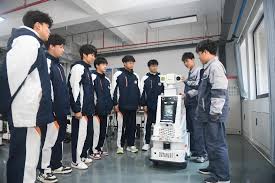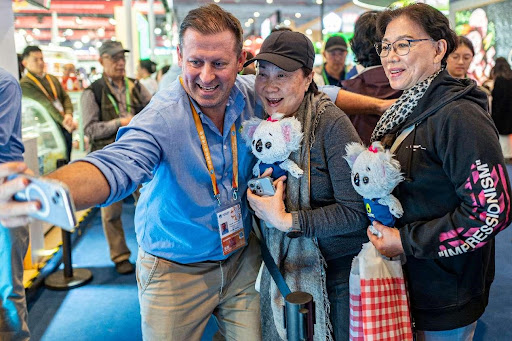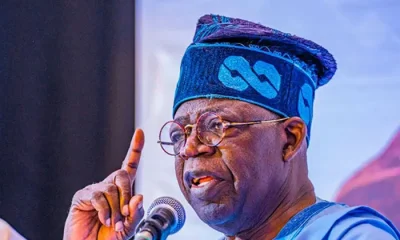Foreign
CIIE to provide new opportunities for world with China’s development

By Luo Shanshan, Ge Mengchao, Yang Xun, People’s Daily
On Nov. 5, the first day of the sixth China International Import Expo (CIIE), the National Exhibition and Convention Center (Shanghai) was bustling with “old friends” and “new friends” who gathered to discuss cooperation.
Walking through the exhibition areas, visitors were often overwhelmed by the vast array of exhibits on display. At this year’s CIIE, the Business Exhibition covered approximately 367,000 square meters, featuring six main exhibition areas and an innovation incubation zone.
In the Consumer Goods exhibition area, a 4.6-meter-tall Lego model was quite eye-catching. Heart shapes, smiley faces and wood ducks imbued with childlike wonder were dotted throughout the structure.
According to a staff member at the Lego booth, this large 3D model was specifically built for the CIIE, which took 18 builders 491 hours to put together.
At the previous five sessions of the CIIE, the Lego Group debuted many new products. This year, it once again launched its latest products at the event, hoping to bring more surprises to Chinese consumers.
The multinational medical device group Elekta brought its latest generation of the Gamma Knife stereotactic radiosurgery system. The group’s founder and boardchairman Laurent Leksell told People’s Daily that the CIIE is a platform for the company to showcase its latest innovative technologies and clinical applications, adding that the group looks forward to exchanging ideas and explore new opportunities with industry partners.
It is reported that at this year’s CIIE, exhibition areas for cutting-edge technologies like energy, low carbon, and AI, as well as lifestyle and consumer goods have grown 30 percent. More than 400 new products, technologies and services were exhibited.
Many agreements on practical cooperation were inked on the first day of the event.
One was signed by the multinational pharmaceutical company AstraZeneca and the Wuxi National High-tech District in east China’s Jiangsu province. According to the agreement, AstraZeneca will expand its production capacity of small molecule drugs in Wuxi.
The pharmaceutical company also inked an agreement on the phase-two project of an inhaler production supply base in Qingdao, east China’s Shandong province. It announced to launch a rare disease cooperation project in the Jinan Innovation Zone of Shandong, to develop more innovative medicines.
Wang Lei, global executive vice-president of UK company AstraZeneca and president of its China branch,, said this year marks the 30th year of AstraZeneca’s entry to the Chinese market, and China has become an important growth engine for the company in the global market.
“We are honored to be able to share the opportunities of the Chinese market through the CIIE,” he noted.
On Nov. 5, Sinochem Holdings held a special signing ceremony at the CIIE, at which it inked agreements with clients from the United States, Brazil, Chile, and other countries in multiple industries such as crude oil and refined oil, food and agricultural products, chemical products, chemical equipment, and service trade.
“Through the CIIE, a global exchange platform, Sinochem Holdings has strengthened cooperation with global energy, chemical, and agricultural companies, effectively expanding the channels for accessing upstream resources in related domestic industries, achieving diversification of import channels, and ensuring the stability of the industrial supply chain,” said Yang Shihao, vice president of Sinochem Holdings.
The CIIE has leveraged the strengths of China’s enormous market, fulfilled its platform function for international procurement, investment promotion, people-to-people exchanges and open cooperation, and made positive contributions to creating a new development pattern and promoting world economic development.
The “CIIE effect” continues to unfold, allowing China’s enormous marketto be shared by the world. This has strengthened the confidence of multinational companies in long-term investment and development in China.
At this year’s CIIE, General Mills, an American food company, announced the full-channel entry of its pet food brand, Blue Buffalo, into the Chinese market. Blue Buffalo made its debut in China at the fourth CIIE and has since benefited from various preferential policies in pilot free trade zones, successfully entering the Chinese market through cross-border e-commerce platforms.
“Over the past two years, we have seen the vast prospects of the pet market in China, which has brought new growth to our business in the country,” said Su Qiang from General Mills.
“We hope to exchange with other players in the industry via the CIIE and build more partnerships,” Su added.
“Through our participation in the CIIE over the past few years, we have fully experienced the powerful spillover effect of this platform. Shiseido’s new skincare brands and products have garnered extensive attention and recognition from consumers after being exhibited at the CIIE,” said Toshinobu Umetsu, president and CEO of Japanese company Shiseido’s branch in China.
He said the CIIE is an epitome of China’s high-level opening up, providing foreign companies operating in China with more market opportunities, investment opportunities and growth opportunities, and allowing enterprises to share the dividends of China’s opening up.
Foreign
China’s new chapter in global innovation

By Gu Yekai, Liu Yiqing, People’s Daily
At a smart construction project site managed by China State Construction Engineering Corporation, a quiet technological revolution is underway. Amid cranes and concrete, engineers are deploying advanced artificial intelligence (AI) systems that could fundamentally reshape the construction industry.
Li Fengjian, an AI specialistwith Xianyuan Technology, detailed how the company’s latest intelligent system – built on a large model – adapts to complex construction environments.”Engineering machinery equipped with intelligent agents can adjust its operations automatically in response to weather conditions,” Li explained, adding that a spatiotemporal sensing network further enhances the system, providing real-time tracking of both personnel and materials throughout the construction site.
In February this year, Xianyuan Technology rapidly integrated its self-developed model with DeepSeek-R1, effectively blending a general-purpose framework with industry-specific models. This integration, Li noted, has produced a solution capable of delivering expert-level performance in challenging, dynamic environments. The firm is based in the Shanghai Foundation Model Innovation Center, aburgeoning AI incubator that now hosts over 200 innovative enterprises.
China’s technological transformation extends well beyond the construction sector. Overthe past three decades, the country has evolved from its initial forays into internet connectivity to becoming a key player in global digital innovation.
Here, a steady stream of technological innovations are emerging, from the early days of emails and web browsing to the cutting-edge technologies represented by DeepSeek and the dynamic evolution of social media.
Wu Jianping, an academician at the Chinese Academy of Engineering and headof the Zhongguancun Laboratory, pointed out that while China had introduced only one internet standard before 2005, it now contributes to over 200 worldwide. Such strides illustrate the country’s concerted push toward high-level technological self-reliance – a journey marked by both persistence and determination.
Beyond the digital realm, China is makingsignificant inroads in aerospace, new energy, and other high-tech sectors. It has transitioned from being a follower to standing shoulder-to-shoulder with global leaders, and in some areas, even taking the lead. Wu attributed these achievements to a dynamic ecosystem of policy reforms and talent cultivation that encourages creativity and technical expertise at every level.
Amid intensifying international competition, collaborative research and the integration of new technologies with traditional industries are central to China’s high-quality economic development.
Mei Linhai, a researcher at China’s State Key Laboratory of Cognitive Intelligence, remarked that the age of AI calls for continuous exploration. “In this era, everyone is an innovator. Only by persistently pushing the boundaries can we remain at the forefront of both technological and industrial development,” Mei observed.
In the field of general-purpose AI, Mei emphasized that independent innovation is paramount. He advocates for a self-driven industrial ecosystem that leveragesbreakthrough technologies to boost productivity and unlock new possibilities, Mei said.
Foreign
Chinese democracy in action:a village bench meeting shapes national law

By Wei Zhezhe, Liu Botong, People’s Daily
In a modest corner of Jiangmen, south China’s Guangdong province, residents of Weidong village are experiencing firsthand a form of democracy that starts at the grassroots level and reverberates all the way to Beijing.
Wu Tengxin, a local villager who relies on a scooter for daily mobility after contracting polio, recalls a time when the village’s public spaces were ill-equipped for people with disabilities. Now, thanks to a simple suggestion made during a meeting, his everyday life has changed.
In November 2022, a team from a local legislative outreach office – a branch of China’sNational People’s Congress (NPC) – visited Weidong village and set up a “bench-style meeting.” Residents, including the elderly and those with disabilities, gathered to voice their concerns about inadequate accessibility.
Amid the conversation, Wu offered a straightforward proposal: “I hope rural accessible facilities can be improved to make mobility easier for people with disabilities and the elderly.” His words were relayed verbatim to lawmakers.
The response was swift. On June 28, 2023, at the third session of the 14th NPC Standing Committee, legislators passed a law on building a barrier-free living environment. The law stipulates that improvements”shall align with social and economic development levels, coordinate urban and rural progress, and gradually narrow the gap in infrastructure between urban and rural areas.”
Today, Wu observes that the village’s main roads and public squares have been upgraded with accessibility features that make getting around considerably easier.
This episode illustrates what Chinese officials call “whole-process people’s democracy” – a system where citizen input is woven into every stage of policy development.
Jilie Ziri, head of Abuluoha village in Butuo county, southwest China’s Sichuan province, remarked that for young generations in China, democracy has become a lived experience. “Villagers are the masters of village affairs,” he said, emphasizing how active villager participation has injected new vitality into local governance.
Experts point to consultative democracy as a cornerstone of this process. Tao Kaiyuan, vice chairman of the Central Committee of the China Association for Promoting Democracy and vice president of the Supreme People’s Court, underscores the important role of the Chinese People’s Political Consultative Conference, whose members hail from every stratum of society and bring a wealth of expertise and connections.
Their regular forums, field research, and public consultations have created robust channels for citizens to contribute ideas and forge consensus.”This approach gathers collective wisdom and transforms public voices into policy,” Tao said.
Another crucial manifestation is the effectiveness of China’s political party system. Under the leadership of the Communist Party of China, Chinese democratic parties actively fulfill their duties, offering recommendations that often translate into concrete policy decisions. This integrated approach demonstrates the unique strengths of China’s political system and the advantages of whole-process people’s democracy.
Tao emphasized that whole-process people’s democracyhas evolved into an efficient and dynamic democratic practice – one that not only reflects the essence of socialist democracy but also presents a pioneering model of political civilization, contributing Chinese wisdom and solutions to global governance and democratic development.
Foreign
Chinese modernization: blueprint for global progress

By He Yin, People’s Daily
At China’s recent annual “two sessions,” Chinese modernization once again captured global attention. International observers are closely following a range of new measures designed not only to accelerate Chinese domestic transformation but also to unlock fresh opportunities for global development.
They believe that Chinese modernization, built on a foundation of openness and cooperation, will continue to yield global benefits with each new milestone.
Today, China stands as a formidable force in the global economy – accounting for around 18 percent of the global economy and nearly 30 percent of world manufacturing output. Year after year, the nation has contributed about 30 percent to global economic growth. With import and export records with almost all countries and regions designated in the United Nations Statistics Division, the country is a major trading partner for more than 150 countries and regions. In 2024, its exports to over 160 countries and regions saw growth.
Often hailed as the “world’s largest developing country,”the “second-largest economy,””world’s factory,””global market,” and “innovation powerhouse,” China is increasingly viewed as a beacon of stability and progress.
In recent years, high-profile events such as the seventh China International Import Expo – where intended deals exceeded $80 billion – and the establishment of over 1.239 million foreign-invested enterprises have reinforced the nation’s reputation as a vast, dynamic market.
Meanwhile, policies encouraging Chinese companies to “go global” have seen a steady stream of new technologies, goods, and services permeate international markets, knitting the country ever tighter into global value chains and bolstering its commitment to win-win cooperation.
The influence of Chinese modernization is evident far beyond its borders. In the Central African Republic, President Faustin-Archange Touadera has repeatedly screened China’s political documentary Carry the Reform Through to the End for cabinet discussions, while officialsin Uzbekistan are adapting China’s poverty-reduction experience to suit their national context. These moves challenge the assumption that modernization must follow Western models, suggesting that China’s alternative pathway offers a viable route to development.
Beyond economic growth, Chinese modernization is increasingly celebrated for its potential to foster win-win cooperation and shared prosperity.
Under the Belt and Road Initiative (BRI), for example, Kazakhstan secured its first maritime access and Laos launched its first modern railway. Support from the Global Development and South-South Cooperation Fund has propelled over 160 projects, benefiting more than 30 million people. Moreover, China has given all the least developed countries with which it has diplomatic relations zero-tariff treatment for 100 percent tariff lines, signaling its commitment to an open and inclusive global economy.
China’s modernization agenda also tackles global challenges head on. In response to global environmental risks, China advocates for building a community of all life on the Earth. To bridge the digital and AI divide, it has launched the AI Capacity-Building Action Plan for Good and for All to ensure that technological advancements benefit every corner of the globe.
On the security front, China continues to promote dialogue and reconciliation in conflict zones while engaging in multilateral security collaborations, reinforcing its reputation as a nation committed to peace and stability.
By proposing initiatives such as the Global Development Initiative, the Global Security Initiative, and the Global Civilizations Initiative, China is not just charting its own course toward modernization but championing an equal and orderly multipolar world and a universally beneficial and inclusive economic globalization – one that seeks to ensure that no nation is left behind on the path to prosperity.
The global appeal of Chinese modernization is far from accidental. Decades of reform and opening up have accelerated its development while enabling the country to contribute to global governance. On the international stage, it has taken on a leadership role – actively shaping global norms, building a community with a shared future for mankind, and advancing world peace and development. By sharing its successful experiences and technological advancements, the country seeks to help other developing countries chart their own courses toward progress.
With over 1.4 billion people engaged in this modernization journey – a number that surpasses the total population of all developed countries combined – China’s approach is redefining the global modernization landscape. For China, modernization is not solely a national endeavor but a blueprint for global progress – a vision that promises a more inclusive future for all.
-

 News10 hours ago
News10 hours agoN10bn Alleged Loot: SGF Akume’s PA ,Torhile Uchi Turns Chinery
-

 News15 hours ago
News15 hours agoObi donates N20m to Colleges of Nursing in Ahiara and Ihiala
-

 News16 hours ago
News16 hours agoKano Emirate Tussle: Appeal Court halts Emir Sanusi’s reinstatement
-

 News7 hours ago
News7 hours agoIPOB’s lawyer accuses Anambra govt of violating citizens’ rights, wants all arrested charged to court
-

 News16 hours ago
News16 hours agoDamagum bows as PDP Govs move to re-assert ‘selves over party affairs
-

 News7 hours ago
News7 hours ago2027: Oyetola’s leadership’ll pave way for APC’s victory in Osun — ex-Speaker
-

 News7 hours ago
News7 hours agoOpposition no longer safe with recruitment of Osun PDP members into Amotekun – APM
-

 News7 hours ago
News7 hours agoJoint patrol team neutralises notorious kidnapper in Nasarawa











